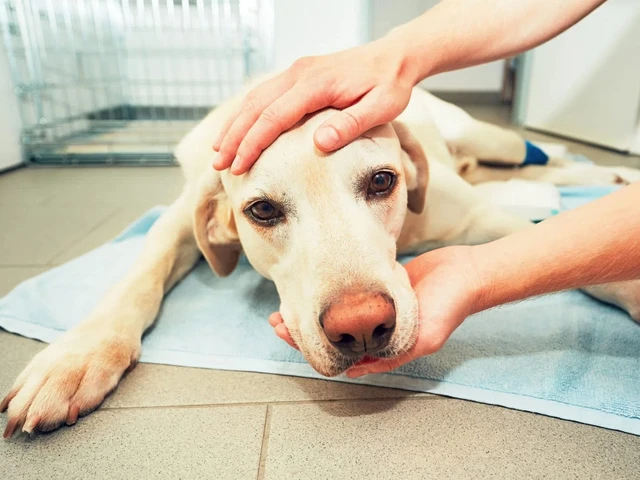Gua Sha for Dogs: How to Use This Tool Safely
Gua Sha is trending for people, but done right it can help dogs too—mainly to boost circulation, ease tight muscles, and encourage lymph drainage. That said, you can’t copy human routines and expect good results. Dogs have different skin, fur, and pain signals. This guide shows plain, practical steps so you can try Gua Sha without causing harm.
How to do Gua Sha on your dog (simple steps)
1) Check with your vet first. If your dog has cancer, bleeding disorders, open wounds, or severe skin problems, skip Gua Sha until a vet clears it. Also rule out pain causes that need medical care.
2) Pick the right tool and lubricant. Use a smooth, rounded-edge tool made of jade, ceramic, or polished horn. Warm it in your hands first. Use a small amount of plain coconut oil or a vet-approved carrier oil so the tool glides; don’t use essential oils directly on the skin.
3) Calm the dog and work in short sessions. Start with 2–5 minutes and watch the dog’s body language. Dogs often tense, lick, or shift away if something’s wrong. Stop if they pull back, growl, or show sudden pain.
4) Technique: part the fur so the tool contacts skin. Use light, slow strokes—think gentle rubbing more than scraping. Move along muscle lines, not directly over bone or the spine. For example, work the neck muscles beside the vertebrae, the shoulders, the large muscles over the ribcage, and the hindquarters. Aim for 5–15 strokes per area, repeating only once if the dog seems relaxed.
5) Frequency: 1–3 short sessions per week is plenty for most dogs. Watch for lasting changes—if mobility improves or the dog seems calmer, you’re on the right track. If symptoms worsen, stop and talk to your vet or a canine massage pro.
Safety tips & when to stop
Keep pressure light. Human Gua Sha often creates red marks or tiny bruises; on dogs, you should avoid causing visible petechiae or bruising. If you see persistent redness, swelling, open sores, or the dog favors a limb after treatment, stop immediately.
Avoid sensitive zones: the belly, groin, directly over the spine, inflamed joints, and any lumps or wounds. Don’t use Gua Sha on very young puppies, elderly dogs with fragile skin, or dogs on blood-thinning meds without vet approval.
Pair Gua Sha with other gentle therapies like myofascial release, light stretching, or relaxation massage. If you want more than basics, seek a certified canine massage therapist who can adapt techniques to your dog’s condition.
Gua Sha can be a quiet, effective addition to your dog-care toolkit if you keep it gentle, short, and watch your dog’s cues. Start slow, stay observant, and get professional advice when in doubt.

Transform Your Beauty Routine with the Power of Gua Sha
Gua Sha, an ancient Chinese skincare technique, is becoming a modern-day beauty must-have. This article shares essential tips, fascinating facts, and a step-by-step guide to incorporating Gua Sha into your skincare routine. Learn how this practice can improve your skin's health and provide a natural, radiant glow.

Unlocking Radiant Skin with Gua Sha Techniques
Discover the ancient art of Gua Sha and how it can transform your skincare routine. Through simple yet effective techniques, this practice promises to help in achieving a glowing complexion. Explore tips, interesting facts, and step-by-step guides to incorporate Gua Sha into your daily ritual effortlessly.

Revitalize Your Skin with Gua Sha Techniques
Discover how to transform your skincare routine with the ancient practice of Gua Sha. Learn about its benefits, how to use it effectively, common mistakes to avoid, and tips for getting the best results. Unveil the secret behind this natural, non-invasive beauty technique.

The Wonders of Gua Sha: A Comprehensive Guide
Join me on a fascinating journey into the world of Gua Sha, a traditional healing technique steeped in centuries-old wisdom. I'll take you through a comprehensive guide, encompassing its incredible benefits and integral role in holistic wellness. Learn about this ancient secret that's been passed down in Traditional Chinese Medicine. Come along, as we explore the wonders, techniques, and effects of Gua Sha on our health and wellness. Ready to illuminate your healing journey? Let's dive right in!

The Power of Gua Sha in Overcoming Chronic Pain
Hi, I'm sharing with you today my journey with Gua Sha therapy and how it has positively impacted my journey with chronic pain. Gua Sha, a traditional East Asian healing technique, has shown immense potential in controlling and managing chronic pain. This simple yet effective therapy is a must-try for someone who has been battling relentless aches for a long time. Join me in my exploration of Gua Sha, its benefits, and how it's made life easier for us chronic pain warriors.

The Science Behind Eating a Healthy Breakfast
Aug, 14 2023

Boost Your Mood with These Aromatherapy Tips
Mar, 19 2025


